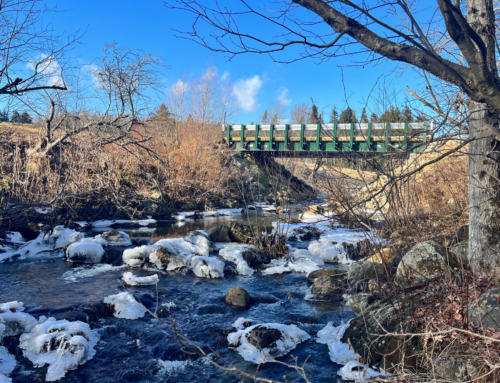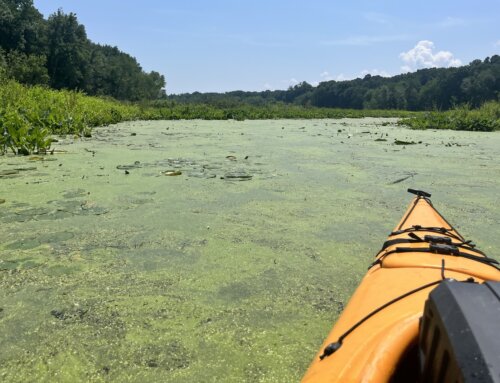Vermont. December 01, 2010. When our rivers turn muddy and murky few people think about what is going on in the riverine ecosystem. That added color is sediment. Sediment is soil, sand, gravel, stones and organic material being transported downstream by the force of the water. In nature rivers move only two things from upstream sources – water and sediment.
Sediment comes from several sources. One source is the river itself. Increased flows cause increased friction between the water and the sides and bed of a river. The water scrapes the particles of soil, gravel and rocks loose from their resting places. Bed load is the sediment the water plucks from the bottom of the river. Bed load particles move by rolling, sliding or hopping down river along the bottom. Stand next to a stream during high spring flows and you can hear the rocks ‘clicking’ against each other. Lighter particles of the fine sand, silt and clay size are transported as suspended load higher in the water column.
The other major sediment sources are overland flow and stormwater runoff. Both transport dislodged soil particles down slope to a river. Depending on the intensity of the rain the soil particles can either be moved by sheet flow as water flows over land surface equally in all places or in channels that form and sweep the particles into a gully. Gully flows that collect sheet flow also move sediment off the bottom and sides of the gully in addition to what came off the land or parking lot. A double whammy!
An increase in flow increases the ability of the water to carry sediment accordingly. It’s a matter of physics and there are equations that calculate the amount of sediment a river can move at a particular flow. The equations not only predict the amount of sediment but where it likely will be deposited within the river channel. When human activities create sloping impervious surfaces like roof tops and parking lots that will not absorb water, those surfaces quicken stormwater flows to waterways. The increased speed with which the water gets to the river increases river flows more quickly and that increases the erosive power of the river.
As you might expect the more force the water has the larger the sediment particles; e.g. flood flows can move boulders. Conversely as the flow levels drop the sediment drops out of the water starting with the biggest particles first. These patterns of erosion and deposition are critical to the health of a river, especially the locations where the sediment is dropped as the flows lower. Where sediment is deposited determines where there will be riffles, pools, runs or point bars formed in the river. The deposition also determines where aquatic insects and other macroinvertebrate life lives, where fish spawn and where they grow to maturity.
People usually don’t distinguish between natural and human influenced sediment releases and if they do they question why one is OK and the other causes problems. In a natural experience as the water level rises the amount and size of the sediment increases and then decrease as the water level drops. Sediment settles out in predictable places in a river and natural deposition of sediment creates a diversity of the river bottom conditions. If a sediment release happens when there is no high water the sediment settles out in the wrong places and causes embeddedness meaning habitat destruction.
Embeddedness is a word used to describe the degree to which gravel, cobble and boulders are buried into the silt, sand or mud of a stream bottom. As a river bottom becomes embedded the open area under rocks, cobble and gravel, the essential habitat for macroinvertebrates and fish for shelter, spawning, and egg incubation decreases. Embeddedness is usually a result of large-scale sediment movement and the more embedded a river is the less healthy it is for aquatic species.
If sediment is released during regular or low flows, sediment drops out of the water column in the wrong places especially the fine materials like silt. This situation can spell doom for aquatic species. Accumulation of sediments in the wrong places in a river increases the embeddedness of a river and that leads to a decline in biodiversity within that reach of river. Fine sediments fill the spaces between gravel and cobble decreasing spawning areas for fish and the habitat for macroinvertebrates that serve as food for many fish species because fine sediment can cover the natural bottom and cut off water circulation and therefore oxygen to fertilized eggs and all other aquatic species that would normally live there.
Sediment is one of the largest sources of pollution in our nation’s rivers. The effects of human factors that can affect the amount of river sediment include changes in the river itself by construction of dams, gravel extraction, thoughtless stream alteration, inappropriate land use and unnaturally higher flows caused by climate change. The changes in these conditions alter the yield of water and sediment in our rivers and not always for the better.
# # #
David Deen is River Steward for the Connecticut River Watershed Council. CRC has been a protector of the Connecticut River for more than half a century.







